
What do New Flyer, Lion Electric, National Steel, Bombardier, and Alstom have in common? They are Canadian companies ready to plan, build and install the new Sea to Sky Commuter Rail Line!
As the title suggests, Think Big. This green and environmentally positive concept is a dream that might have momentum if Big Thinking gets underway. Now, is the most appropriate time to get it going. Canada is seeking projects that will engage new levels of national and regional economic growth. The Sea to Sky needs other forms of transportation beyond the increasingly busy highway. The Earth needs smarter ideas.
In earlier times, passenger rail was a splendid way to travel. It still is in Europe and other parts of the world. Canada did an amazing job of building the CPR and the CNR in the past but alas, the gas engine industry prevailed. Today, there is a stronger sense of building public transportation in a sustainable way.
Here, then, is the Big Idea!
Bring together the creative and innovative energy to address a Pilot Project Philosophy (PPP) that will get things going. The companies mentioned above are thirsty for large scale projects that engage the public and private sectors into play. They are Canadian and at last count, Canada has steel and aluminum, and copper and goodness knows what else can go into the building of modern, efficient, and amazing rail cars to zip along the Sea to Sky rail line from Pemberton to Lonsdale in North Vancouver.
In the recent past, the Budd Car was an attempt to catch the last of the passenger traffic. Now, think rail vehicles like the articulated buses that ply the streets of many cities; but ultra comfortable.
BC highways and certainly the Sea to Sky have become busy. The government continues to fund the highways all the while bemoaning the cost of repairs, upgrades, policing, accident response and the pollution they bring. What would it look like if some of that funding went into a PPP for commuter rail in the Sea to Sky Corridor?
How often does serendipity happen? It could be happening now as CN Rail’s 3-year plan calls for a decommissioning of parts of their rail line in the Squamish to Lillooet area. Indicators are that MP Patrick Weiler and MPP Jeremy Valeriote have voiced support for a good review of passenger service in our area. This could be the catalyst that is needed.
Speaking of funding, the robust budget of ICBC can kick start the necessary pilot research study funding. BC Ferries started as a government enterprise and has morphed into a sort of private entity. The government did do the early heavy lifting to get it underway. The government is not in the ferry business and so, too, the private sector will need to engage in a rail solution.
European trains are private corporations that compete for the public attention. If you have travelled by rail in Europe, you must have asked the question – why can’t Canada have such trains? We can. We just need to do it.
The Quebec City to Windsor Corridor also needs fast rail. However, that is a massive undertaking. Better a pilot project in the Sea to Sky Corridor to work out the wrinkles before tackling the big one.
There is no better place than the Sea to Sky to undertake a pilot project of this nature. Mentioning Nature, think of the plus side with electrified rail instead of diesel and gas engines. Mentioning Nature again, think of the magnificent scenic beauty of sitting in a sky view coach without concentrating on the highway – ‘Howe Sound’ is that idea?
Steps to take:
– Commence the research study to address the concept.
– Then consult and communicate with all levels of public.
– Thirdly, bring together all the players – government, First Nations, ICBC, research labs and the industrial partners and pension funding.
– Then get the contracts signed and get underway.
Sounds easy, right? No, it is not. It is a complex undertaking that will require excellent leadership, careful planning, intensive discussions, and amazing implementation.
This requires a shared vision of a preferred future that is in harmony with the Earth and what is better for people. How can we help to make this a reality?
After teaching stint at Nipissing University and working as an administrator at the Maple Leaf International School in Trinidad & Tobago, Larry Murray moved to Squamish and became the founding Chair of the Squamish Oceanfront Development Corporation. Murray has served as the past chair of Sea to Sky Crime Stoppers and as a past director and Eagle Watch coordinator with the Squamish Environment Society. He has also done consulting work with SD44 and contributed to the new Cheakamus Centre.


Why reference Larry Murray at the conclusion of this article. Did he write it?
If I understand it correctly CN is cancelling rail service from Squamish northbound. They will still operate the rails southbound to Vancouver. How do the companies mention plan to work around this? I think it’s too expensive to plan passenger trains only from Squamish to Pemberton? Is it feasible to go further? to 100 Mile?
Good on you Larry. Your constant push for things as they could be is an inspiration… hopefully to all.